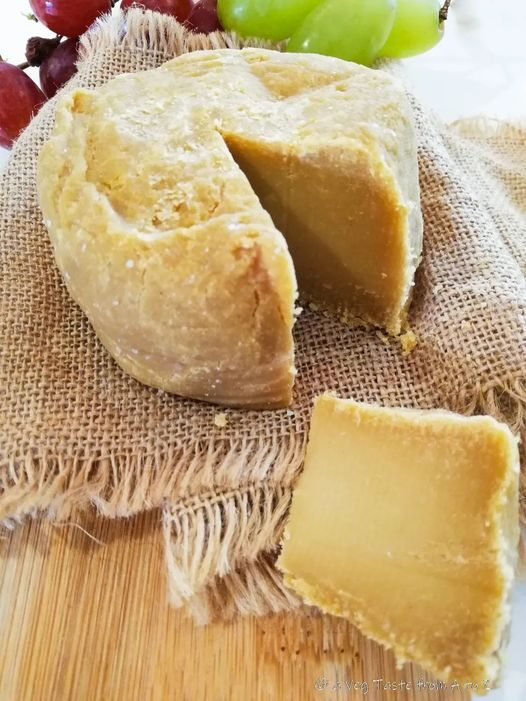
Savoury, light crusted and full of flavour, this aged plant based cheese, starts with a humble can of chickpeas and is really simple to make.
Prep Time10 mins
Cook Time10 mins
Total Time20 mins
Servings: 10 people
Calories: 109kcal
Equipment
- Cheese Mould
Ingredients
- 250 g Chickpeas canned/pre cooked
- 25 g Shea Butter or Refined Coconut Oil
- 50 g Vegetable Oil Rapeseed
- 10 g Nutritional Yeast
- 7 g Salt
- 3 Probiotic Capsules the same ones used here
- 2-3 tbp of boiling water
Instructions
- Drain the precooked chickpeas, and weigh out 250g and then boil them in filtered water for 10 minutes (this procedure will not only make them softer but will also eliminate any bacteria).
- Add all ingredients (minus the probiotics) to the bowl of a powerful food processor and blend until smooth, creamy and lump-free. You may need more or less water than the indicated doses, so I recommend starting with a spoonful and gradually increasing the dose until you get a rather sticky, but not excessively wet, dough. We are looking for a pate texture here.
- As soon as we are happy with the consistency of our mixture, we pour the contents of the probiotic capsules (or sachets), and we give everything a last mix in order to incorporate them as well.
- Transfer the mixture into a glass bowl with a lid (alternatively glass bowl with plastic wrap, do not use plastic!), Then distribute it well and cover with the lid without sealing it. If you are using cling film, make a couple of holes with the fork.
- Let it ferment 24 hours outside the fridge in an area that reaches a maximum of 20 degrees, not in direct contact with lights or heat sources.
- The next day, let’s get a ricotta mould or container (I also use empty hummus containers), sprinkle the bottom with table salt (in flakes or fine), then take the dough with a spatula and go to the inside, compacting it gently. We then also salt the surface with a couple of pinches of fine salt or flakes, and place in the fridge on a plate inside with a glass bowl placed upside down over it, covering the mould containing the cheese with a glass or ceramic bowl.
- Leave it covered for 2 or 3 days, taking care to pat dry any condensation that has formed on the plate and in the glass bowl every day with a clean cloth. After this time the cheese will have slightly hardened.
- Cut a square of parchment paper 2-3 cm larger than the circumference of the cheese, place it on a clean plate, then gently turn out our chickpea caciotta over it. If it is still too soft, try to compact it with a spoon.
- Cover with another sheet of baking paper and place in the top compartment of the fridge inside the bowl.
- Once a day, for about 12-14 days, turn the cheese upside down, taking care to replace the parchment paper if it is too wet, and dry the plate and bowl with a clean cloth. If in the meantime some white pins appear on the “crust”, scrape them off with a knife.
- After about two weeks the cheese is ready to be wrapped in kitchen paper or cheese paper (make sure it does not contain beeswax, as it is not vegan) and continue maturing on the top shelf of the fridge for another 45-60 days.
- After the maturation time, you will have a cutting cheese, with a light crust, savory and with an intense flavour, ideal for grating on first courses, for creaming risottos, for enriching your dishes or simply to taste as it is.
Nutrition
Calories: 109kcal | Carbohydrates: 7g | Protein: 3g | Fat: 8g | Saturated Fat: 6g | Potassium: 93mg | Fiber: 2g | Sugar: 1g | Vitamin A: 7IU | Calcium: 12mg | Iron: 1mg
